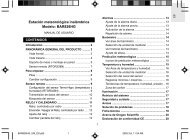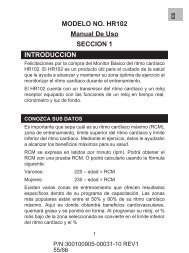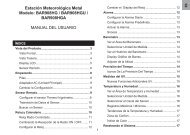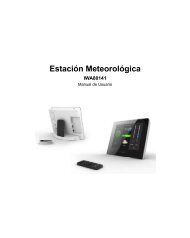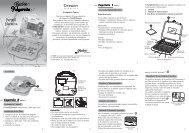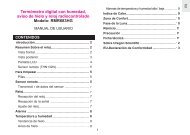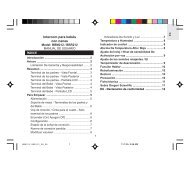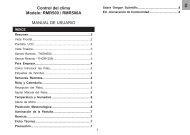Weather Station with Radio-Controlled Alarm ... - Oregon Scientific
Weather Station with Radio-Controlled Alarm ... - Oregon Scientific
Weather Station with Radio-Controlled Alarm ... - Oregon Scientific
You also want an ePaper? Increase the reach of your titles
YUMPU automatically turns print PDFs into web optimized ePapers that Google loves.
EN<br />
4. Slide “°C/°F” switch to select between Celsius<br />
and Fahrenheit.<br />
5. Replace the battery door.<br />
6. Press “+/CHANNEL” key to select the desired<br />
channel.<br />
and “--”<br />
(Outdoor<br />
temperature<br />
Area)<br />
Note When the sensor signal is received, the icon<br />
“ ” will be displayed on the LCD.<br />
OPERATING THE SENSOR<br />
Main unit is searching for the sensor(s)<br />
(the icon will be flashing)<br />
The sensor(s) cannot be found<br />
Sensor 1 has been found<br />
(the icon will be displayed,<br />
but won't flash)<br />
The sensor(s) cannot be found after<br />
operating the main unit for 60 minutes<br />
1. Remove the battery door and slide<br />
“CHANNEL” switch to synchronize the channel<br />
<strong>with</strong> receiver.<br />
2. Insert 2 new AAA size batteries as per the<br />
polarity information marked on the battery<br />
compartment.<br />
3. Press “RESET” key to restart the clock.<br />
4. Replace the battery door.<br />
Note<br />
The transmission range may vary depending on<br />
many factors. You may need to experiment <strong>with</strong><br />
various locations to get the best results.<br />
Standard Alkaline batteries contain significant<br />
amounts of water. Because of this they will freeze<br />
in low temperatures of approximately -12°C (10°F).<br />
Disposable Lithium batteries have a much lower<br />
threshold for temperature <strong>with</strong> an estimated<br />
freezing range of below -30°C (-22°F).<br />
Wireless ranges can be impacted by a variety of<br />
factors such as extremely cold temperatures.<br />
Extreme cold may temporarily reduce the effective<br />
range between the sensor and the base station. If<br />
the unit’s performance fails due to low temperature,<br />
the unit will resume proper functioning as the<br />
temperature rises to <strong>with</strong>in the normal temperature<br />
range (i.e. no permanent damage will occur to the<br />
unit due to low temperatures).<br />
5



